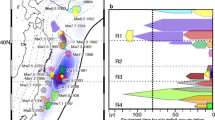Abstract
—We compiled 67 large earthquakes which occurred at and around plate boundaries for the last 140 yrs, and classified them into four groups; interplate strike-slip events, intraplate strike-slip events, underthrust events at island-arc subduction zones, and underthrust events at continental-margin subduction zones. For each group of earthquakes we examined relations between seismic moment M 0, fault length L, fault width W and average fault slip D, and found the following scaling laws. In the case of interplate strike-slip events, the well-known L-cubed dependence of seismic moment breaks down when L exceeds 30 km, because the extent of the seismogenic zone is limited in depth (≤12 km). For large events (L≥ 30 km), D and M 0 increase with L as \(D=\overline {\rm \Delta \tau}L /\mu (\alpha L+\beta )\) and \(M_{0}=\overline {\rm \Delta \tau W}L^{2} / (\alpha L+\beta)\), respectively, where the mean fault width \(\overline {W}\) is 12 km and the mean stress drop \(\overline {\rm \Delta \tau}\) is 1.8 MPa. Here μ, α and β are structural parameters. For intraplate strike-slip events we obtained nearly the same relations, except for significantly higher stress drop (3.1 MPa). The difference in stress drop between interplate and intraplate events may be ascribed to the difference in stress accumulation rates and thus the recurrence time of earthquakes. In the case of underthrust events at island-arc subduction zones we also found the saturation of fault width (\(\overline {W}\) = 120 km) and the breakaway from the L-cubed dependence of M 0 for events larger than L = 200 km. If we consider the average dip-angle of plate boundaries at island-arc subduction zones to be 20–30°, this indicates that the extent of the seismogenic zone in depth is limited to 40–60 km. In the case of continental-margin subduction zones, on the other hand, we could not find the saturation of fault width nor the breakaway from the L-cubed dependence of M 0 from the analysis of the present data set (W≤ 200 km, L≤ 1000 km). For sufficiently large earthquakes, in general, the downward rupture growth is limited to a certain depth due to the existence of a ductile unstressed region which extends under the brittle seismogenic zone. Since the brittle-ductile transition occurs at 300–400°C, the difference in the lower limit of the seismogenic zones between tectonically different regions may be attributed to the difference in thermal state there.
Similar content being viewed by others
Author information
Authors and Affiliations
Additional information
Received July 30, 1999; revised March 21, 2000; accepted April 6, 2000
Rights and permissions
About this article
Cite this article
Fujii, Y., Matsu’ura, M. Regional Difference in Scaling Laws for Large Earthquakes and its Tectonic Implication. Pure appl. geophys. 157, 2283–2301 (2000). https://doi.org/10.1007/PL00001085
Issue Date:
DOI: https://doi.org/10.1007/PL00001085



